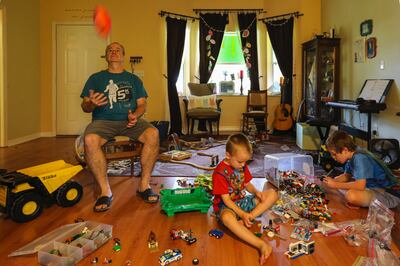Marie Kondo made a big impact back in 2011 when her book, The Life-Changing Magic of Tidying Up: The Japanese Art of Decluttering and Organising, became a surprise bestseller, and her motto about “sparking joy” set off cultural conversations about what to keep and what to throw out of the house.
However, it seems the author and organisational consultant has had a change of heart in her approach to tidying, since having her third child. “My home is messy, but the way I am spending my time is the right way for me at this time at this stage of my life,” she told The Washington Post.
Kondo’s new book, Kurashi at Home: How to Organise Your Space and Achieve Your Ideal Life, focuses on the concept of “kurashi”, meaning “way of life”, allowing for more leeway when it comes to keeping things tidy.
“Up until now, I was a professional tidier, so I did my best to keep my home tidy at all times,” she said in an online webinar. “I have kind of given up on that, in a good way for me. Now I realise what is important to me is enjoying spending time with my children at home.”
But how do UAE parents manage to keep things tidy at home and what have they learnt to let slide?
Adapting expectations

“I’m not going to lie, I’m not especially Type A,” says mother-of-two Helen Farmer, a radio host on Dubai Eye 103.8FM. “I’ve always had a ‘chairdrobe’ and I hate ironing. My home is never unclean, I should clarify, but I'm not a big one for looking like you live in a show home. Life is chaotic, and our house reflects that to varying degrees.”
There’s no denying that children and mess go hand in hand. Toys abandoned in the middle of the room, sticky fingerprints on furniture, odd socks down the back of the sofa ... the creative ways youngsters can bring chaos to the home are endless. This means parents need to manage their expectations about what they consider “tidy”.
“My wife and I have definitely had to adapt to our new reality of a messier home, because young children can’t be expected to work around what we want,” says Karan Mehta, a father of two who lives in Abu Dhabi. “The house was still very tidy when we brought our first newborn home. As he grew into a toddler and was joined by his sister, the mess just seemed to spread. But as long as things are relatively neat, we’re OK with that.”
Bending the rules
With varying lifestyles and schedules that change from day to day, having a loose rather than strict set of rules works better.
“Since having kids, the ‘stuff’ just kept growing and the front room was overrun with toys," says Kate Hogg, mother to five boys aged five, nine, 11, 12 and 13. "I tried to teach my boys to tidy up before we got the next toy or game out, but some days were more effective than others.
"Typically I wouldn’t mind toys being out during the day, and clearing up when bedtime came. I’ve always been someone who needs a tidy space by the evening, so I can sit and chill properly,” she adds.
Allowing that some days will be messier than others, particularly on weekends when the whole family is home together, is key to developing a greater acceptance that the home won’t always be tidy.
“We tend to make sure the house is tidy, surfaces clear, dishwasher on and so on, before bed,” says Farmer. “I only really get upset or annoyed by the mess when it's disrespectful: leaving things on the floor in the expectation that someone else will pick it up — which we won't — or not understanding that clothes and toys cost money, and not being careful with them.”
Getting the children to help
Blogger and author Susie Allison, whose Busy Toddler Instagram page has more than 1.9 million followers, is a firm believer in using clear instructions and turning tidying into a game to engage children.
“The idea of clean-up is really abstract to kids: Clean up what? How long? Why?” she says. “And in the abstractness, they lose focus or interest, and give up. It’s too much and overwhelming. When kids know what to clean, how to clean, or how long to clean, they’re more successful at helping.”
She suggests being “concrete” in your instructions, such as asking children to pick up a certain number of toys to put away, or giving them a specific task such as: “Your job is to put the blocks away.”
She also suggests giving time limits that children understand, say by putting on music and tidying for the duration of their favourite song.
“My boys take charge of keeping their bedrooms tidy,” says Hogg. “They each have their own laundry baskets, too, which has been working well. Over the years, we have given pocket money for extra chores they have helped with. However, when it comes to their own bedrooms, their only incentive is they get to enjoy a clean and tidy room.”
Farmer adds: “My girls get pocket money each week, but it’s not tied to helping around the house. The emphasis is on being part of the family and contributing to our home life.”






